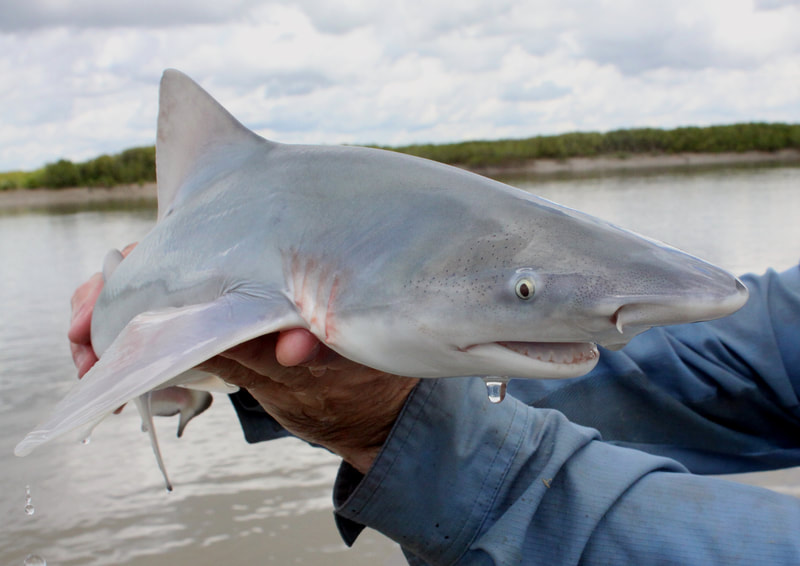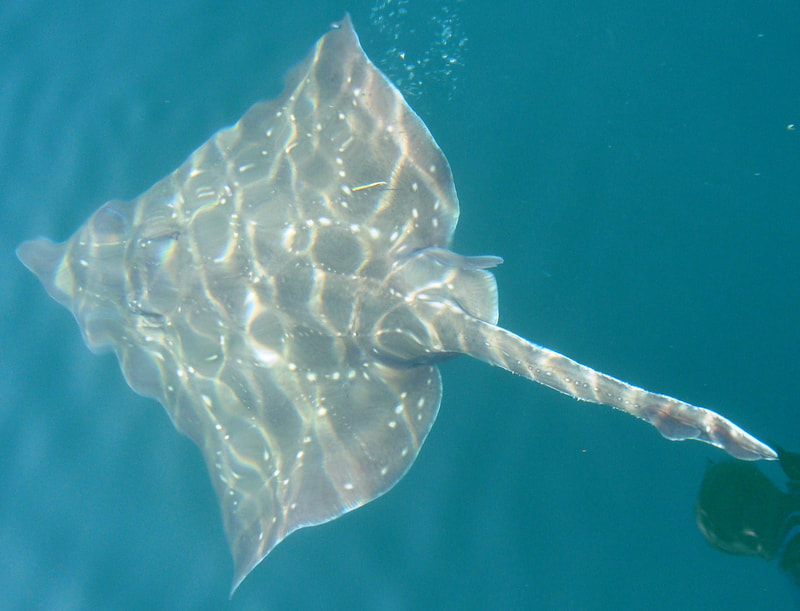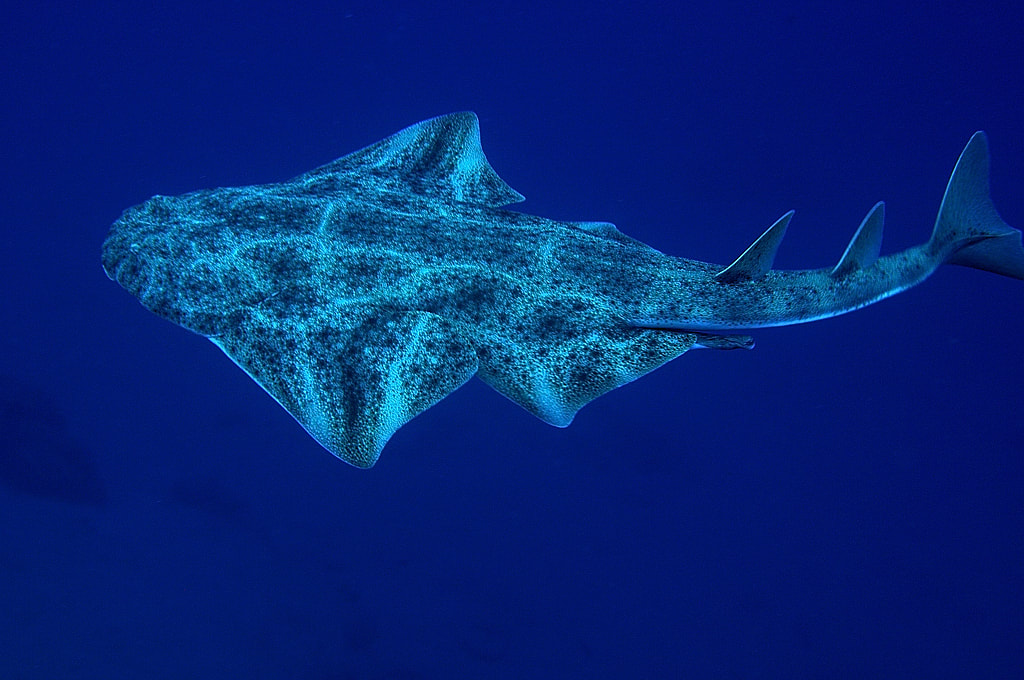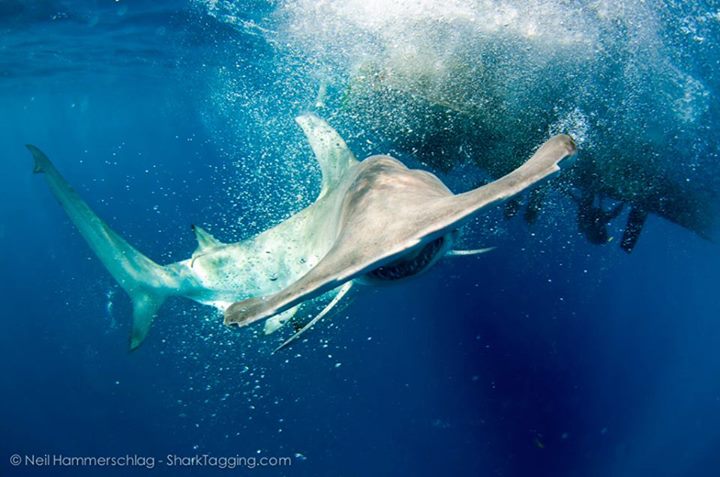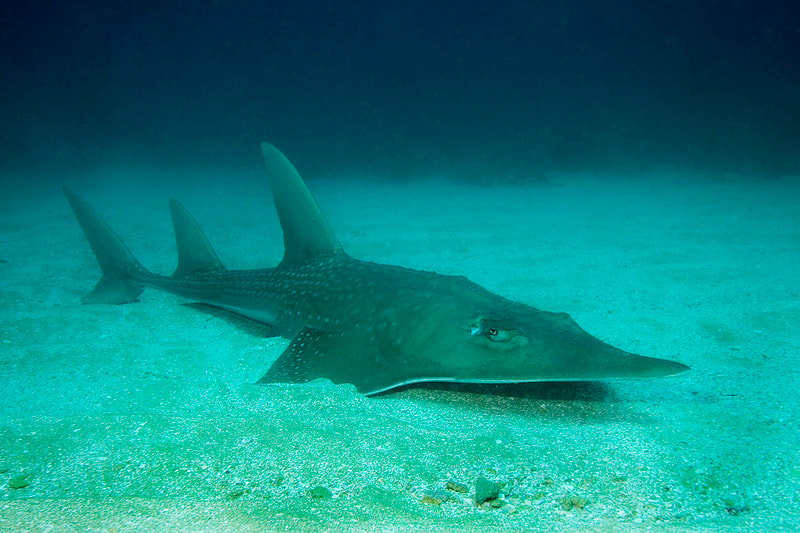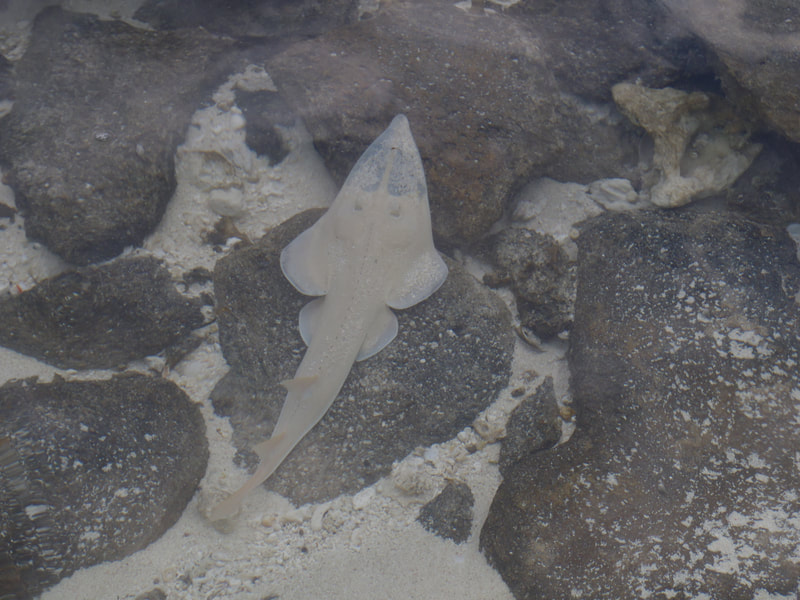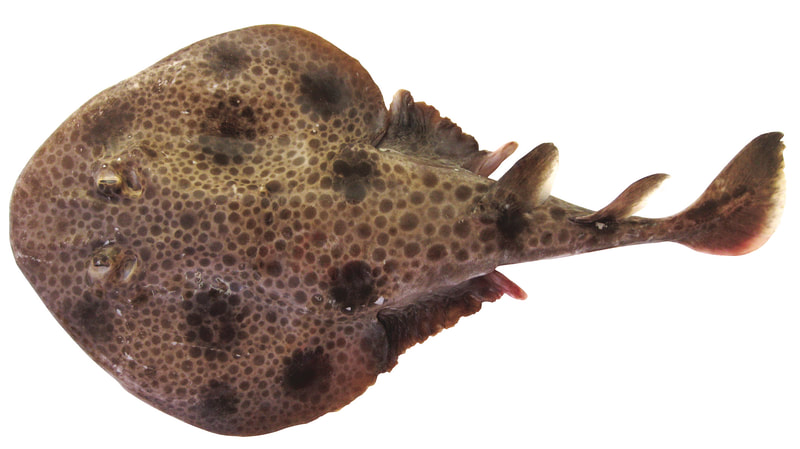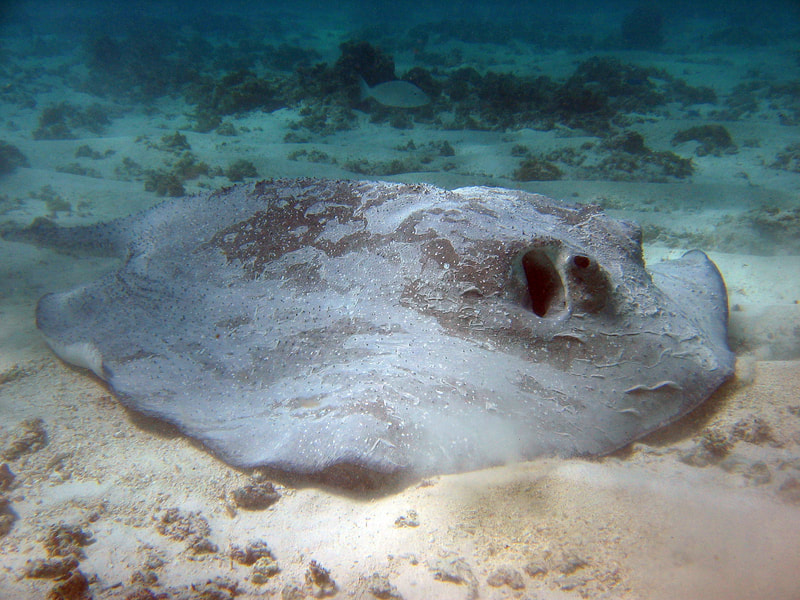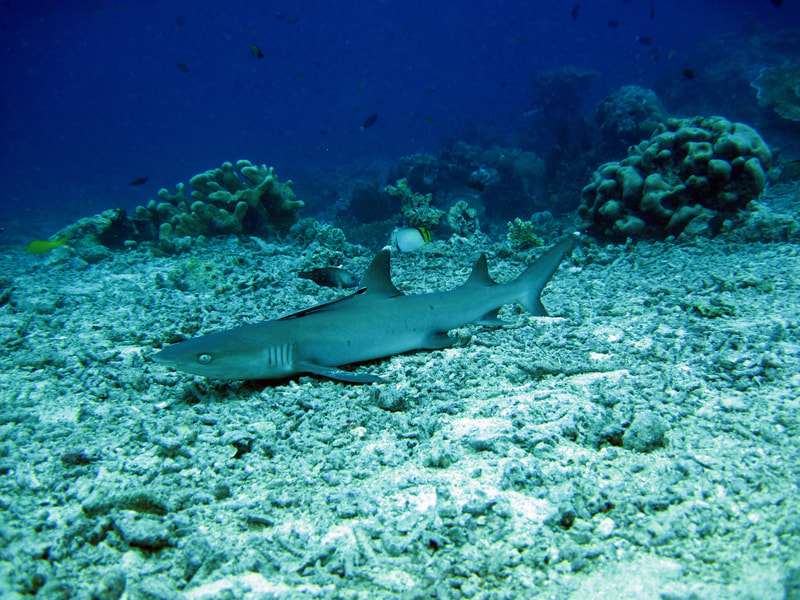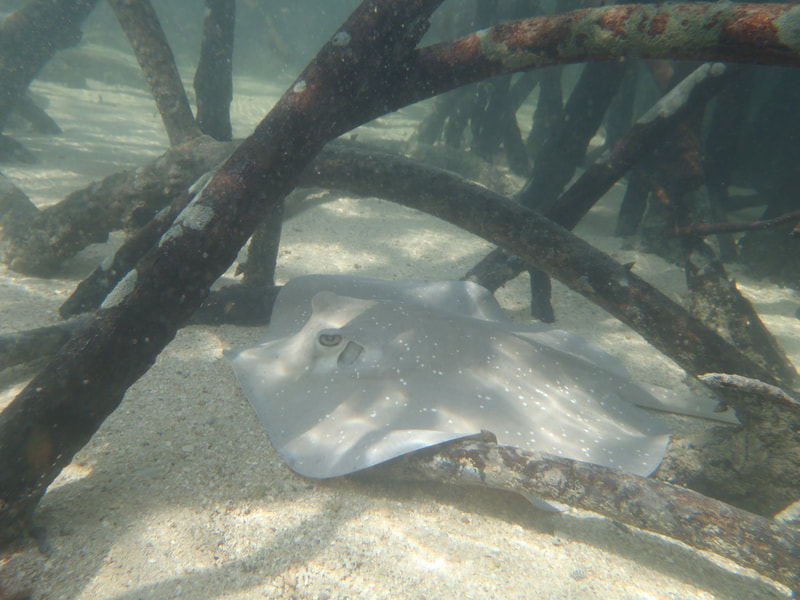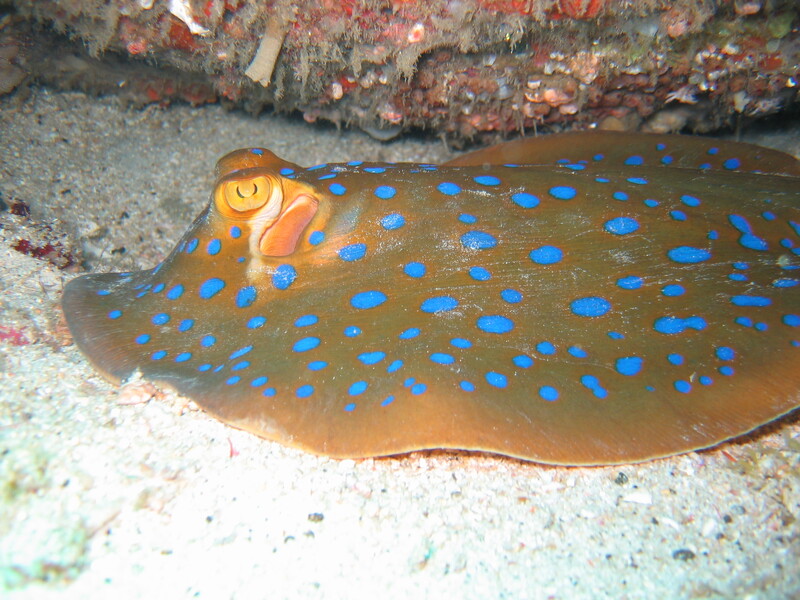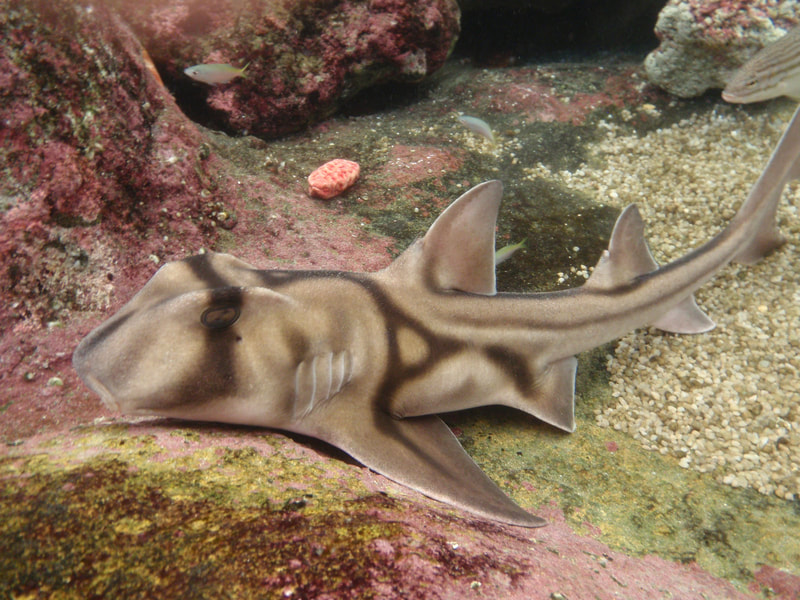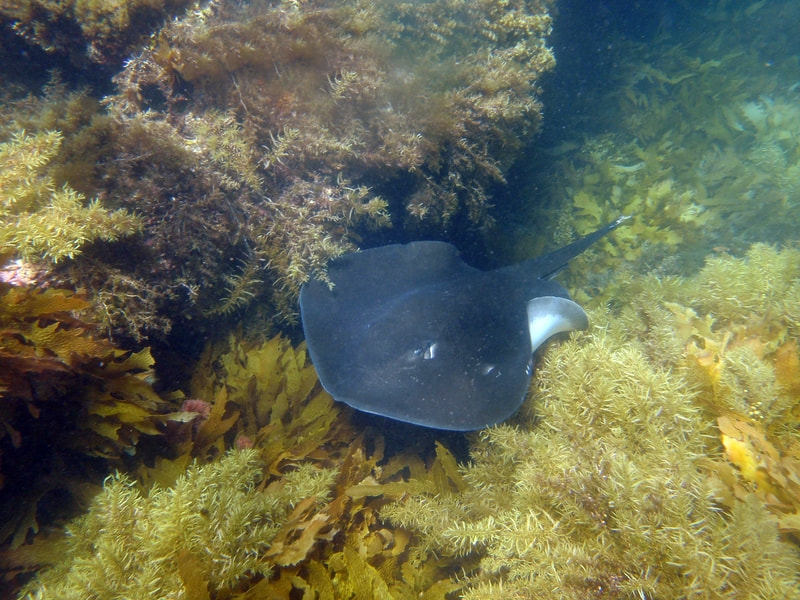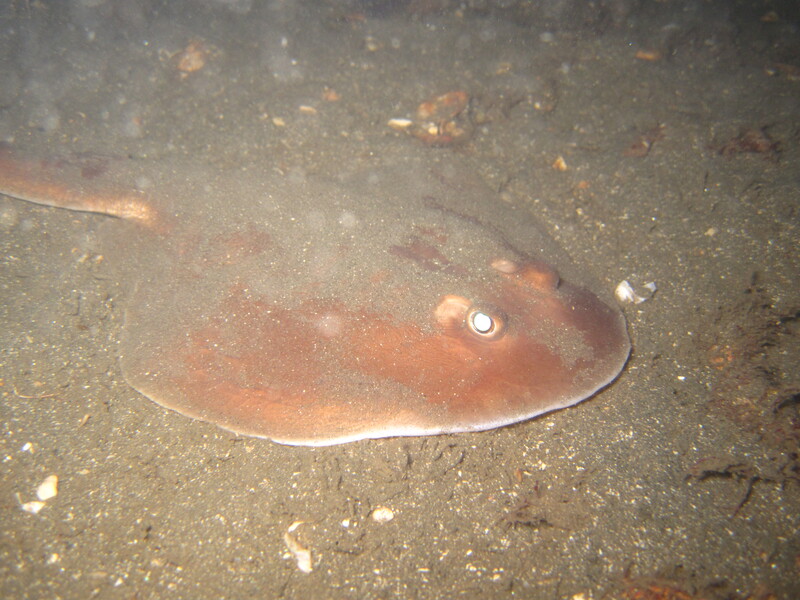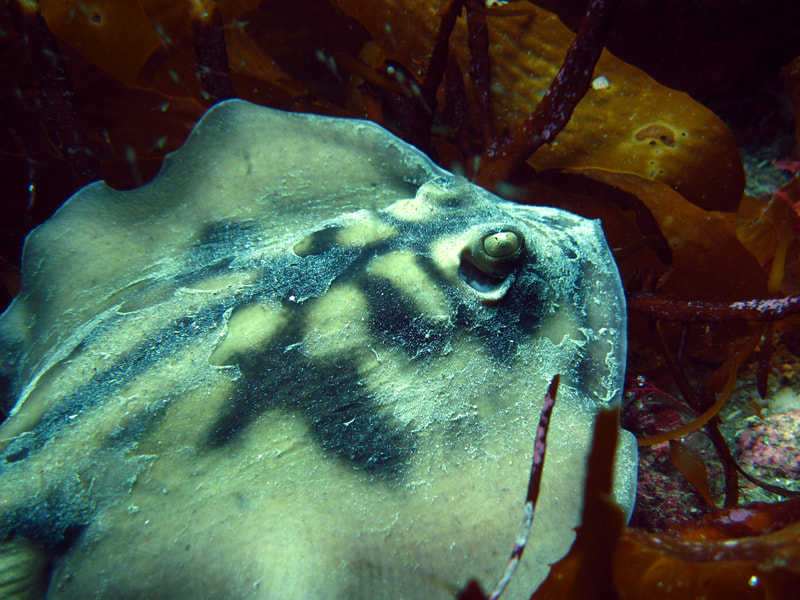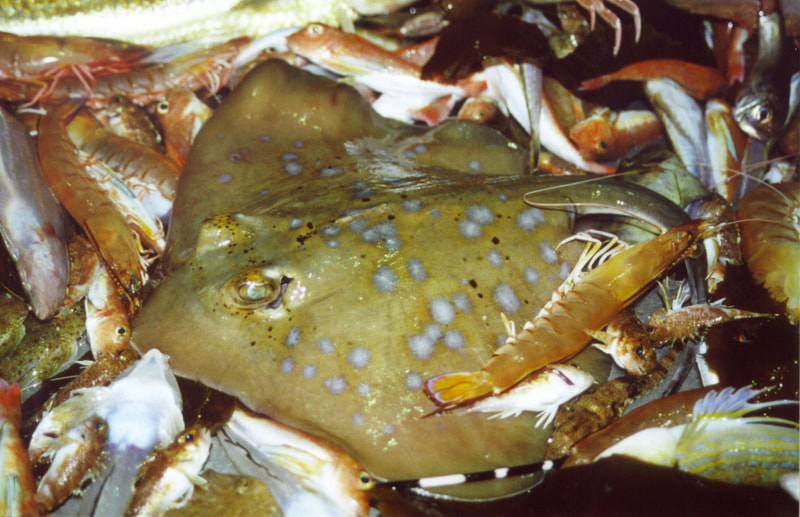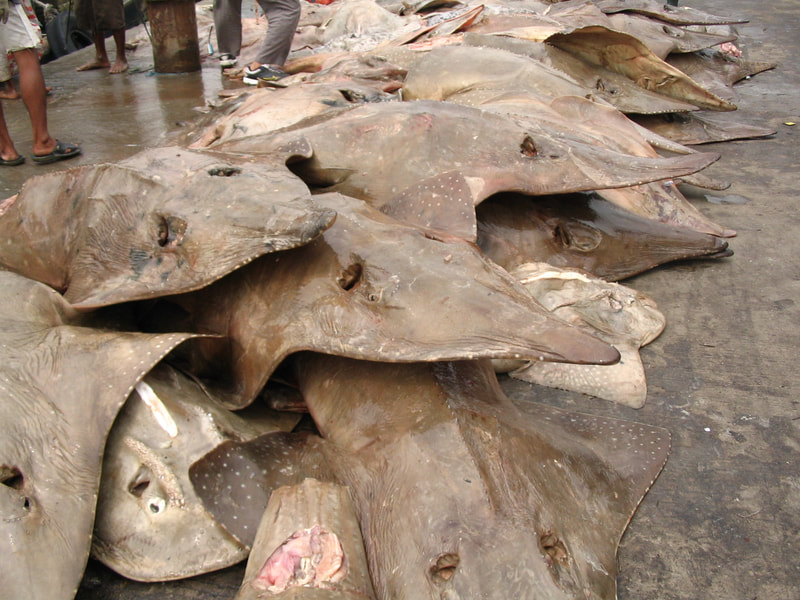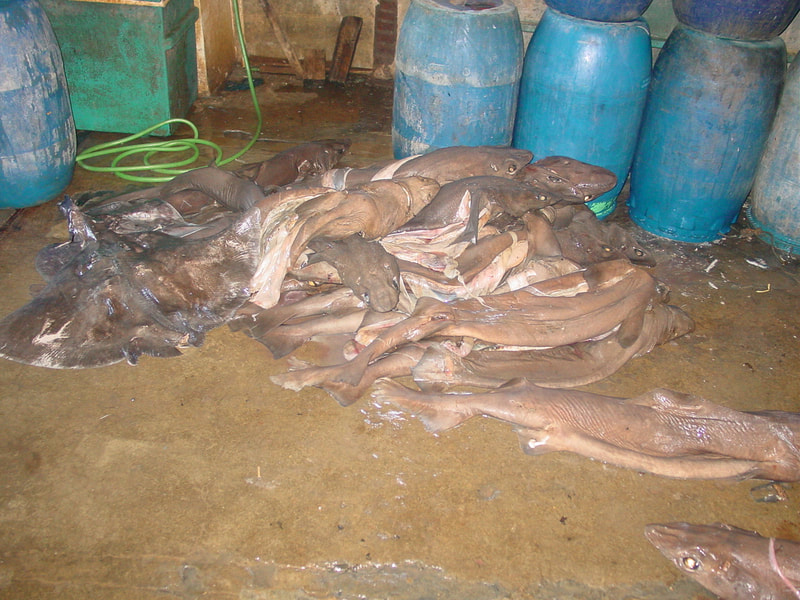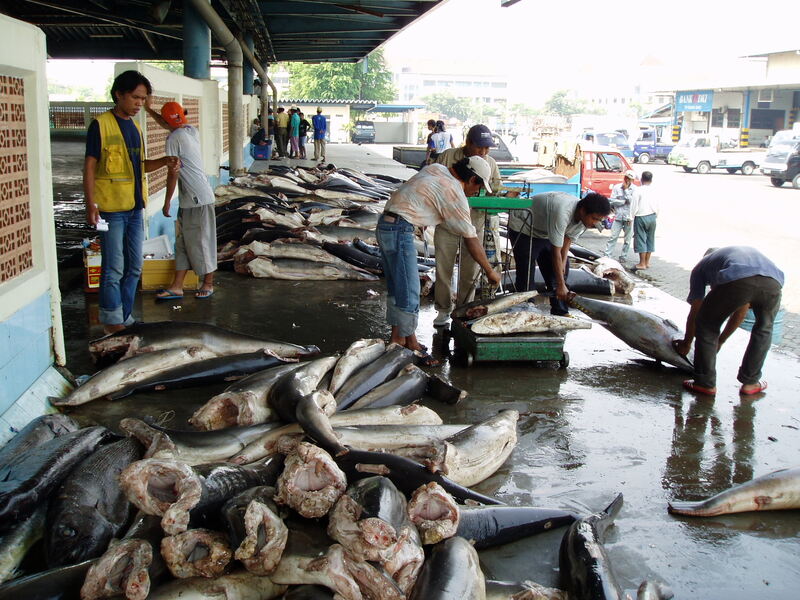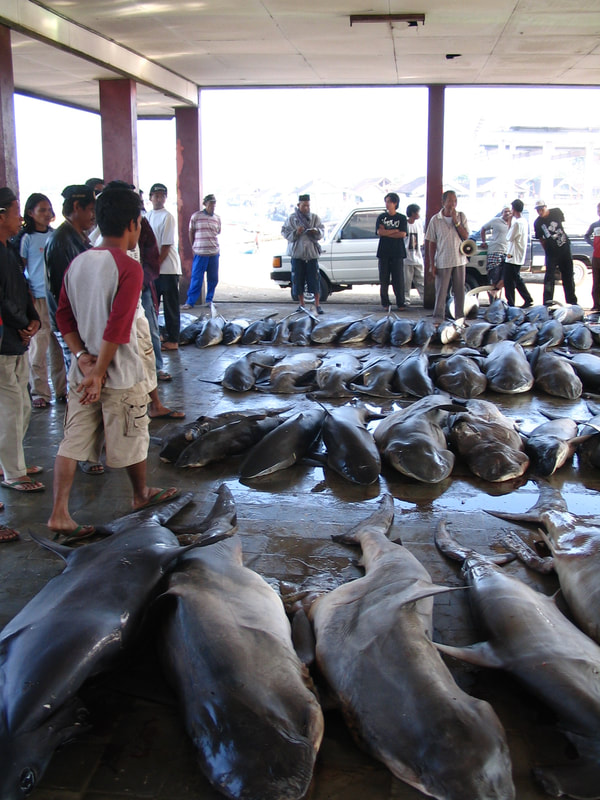Images and Captions for Media Use
Below are low/medium resolution photos for use by media if appropriately credited. Higher resolution images are available here.
Here is a brief guide to the kind of images available:
Here is a brief guide to the kind of images available:
- First, the threatened (Critically Endangered, Endangered and Vulnerable) species.
- Second, Near Threatened and Least Concern species.
- Third, fisheries catch, fish processing and landing sites.
Visit these specific pages for images and captions for media use also:
Species Listed as Critically Endangered
Top Left: Research on chondrichthyans, including this Critically Endangered Northern River Shark (Glyphis garricki), is providing information for management and recovery of threatened species. Photo Credit: Grant Johnson.
Top Centre: The Critically Endangered Flapper Skate (Dipturus intermedius) reaches a maximum length of at least 2.5 m. This egg-laying ray, and others like it, has been eliminated from shallow temperate seas throughout its range an is only found in a few deepwater places and rocky habitats that are too difficult to trawl. Photo Credit: Scottish Sea Angling Conservation Network (SSACN).
Top Right: The Critically Endangered Angel Shark (Squatina squatina) has almost disappeared from European waters and can now only be found with any regularity in the Canary Islands. It was formerly a common and important bottom-dwelling predator over large areas of its coastal and outer continental shelf sediment habitat in the Northeast Atlantic, Mediterranean and Black Seas. Most of this region is now subject to intense demersal fisheries, and the species is highly vulnerable (from birth onwards) to bycatch in the benthic trawls, set nets and bottom longlines operating through most of its range and habitat. Photo Credit: Tony Gilbert.
Bottom Left: The Great Hammerhead Shark (Sphryna mokarran) is a large, widely distributed, tropical shark largely restricted to continental shelves that is listed as Critically Endangered. It is highly valued for its fins (in target and incidental fisheries), suffers very high bycatch mortality and only reproduces once every two years, making it vulnerable to overexploitation and population depletion. Photo Credit: Neil Hammerschlag.
Bottom Centre: Guitarfishes and wedgefishes are among the most threatened rays, due to the high value of their large fins. This Whitespotted Wedgefish (Rhynchobatus djiddensis) reaches over 3 metres long and is classified as Critically Endangered by IUCN. Photo Credit: Matt D. Potenski.
Bottom Right: Juvenile Giant Shovelnose Ray (Glaucostegus typus) Heron Island, Great Barrier Reef, listed as Critically Endangered by IUCN. Photo Credit: Michelle Heupel, Australian Institute of Marine Science.
Top Centre: The Critically Endangered Flapper Skate (Dipturus intermedius) reaches a maximum length of at least 2.5 m. This egg-laying ray, and others like it, has been eliminated from shallow temperate seas throughout its range an is only found in a few deepwater places and rocky habitats that are too difficult to trawl. Photo Credit: Scottish Sea Angling Conservation Network (SSACN).
Top Right: The Critically Endangered Angel Shark (Squatina squatina) has almost disappeared from European waters and can now only be found with any regularity in the Canary Islands. It was formerly a common and important bottom-dwelling predator over large areas of its coastal and outer continental shelf sediment habitat in the Northeast Atlantic, Mediterranean and Black Seas. Most of this region is now subject to intense demersal fisheries, and the species is highly vulnerable (from birth onwards) to bycatch in the benthic trawls, set nets and bottom longlines operating through most of its range and habitat. Photo Credit: Tony Gilbert.
Bottom Left: The Great Hammerhead Shark (Sphryna mokarran) is a large, widely distributed, tropical shark largely restricted to continental shelves that is listed as Critically Endangered. It is highly valued for its fins (in target and incidental fisheries), suffers very high bycatch mortality and only reproduces once every two years, making it vulnerable to overexploitation and population depletion. Photo Credit: Neil Hammerschlag.
Bottom Centre: Guitarfishes and wedgefishes are among the most threatened rays, due to the high value of their large fins. This Whitespotted Wedgefish (Rhynchobatus djiddensis) reaches over 3 metres long and is classified as Critically Endangered by IUCN. Photo Credit: Matt D. Potenski.
Bottom Right: Juvenile Giant Shovelnose Ray (Glaucostegus typus) Heron Island, Great Barrier Reef, listed as Critically Endangered by IUCN. Photo Credit: Michelle Heupel, Australian Institute of Marine Science.
Species Listed as Endangered
The Pelagic Thresher Shark (Alopias pelagicus), at Monad Shoal, near Malapascua Island in the Visayan Sea of the central Philippines. This species is listed as Endangered on the IUCN Red List of Threatened Species. Photo credit: Bo Mancao.
Species Listed as Vulnerable
Top Left: The Shortlip Electric Ray (Narcine brevilabiata) from Sarawak, Borneo Indonesia is listed as Vulnerable by IUCN. Photo credit: Australian National Fish Collection, CSIRO.
Top Middle: The Mangrove Whipray (Urogymnus granulata) at Ningaloo Reef Marine Park, Western Australia s listed as Vulnerable by IUCN. Photo Credit: Australian National Fish Collection, CSIRO.
Top Right: The Whitetip Reef Shark (Triaenodon obesus) from Sipadan Island, Borneo, Indonesia is listed as Vulnerable by IUCN. Photo Credit: Australian National Fish Collection, CSIRO.
Bottom Left: The Vulnerable Mangrove Whipray (Urogymnus granulata) resting in mangrove roots, Orpheus Island, Great Barrier Reef. Photo Credit: Michelle Heupel, Australian Institute of Marine Science.
Top Middle: The Mangrove Whipray (Urogymnus granulata) at Ningaloo Reef Marine Park, Western Australia s listed as Vulnerable by IUCN. Photo Credit: Australian National Fish Collection, CSIRO.
Top Right: The Whitetip Reef Shark (Triaenodon obesus) from Sipadan Island, Borneo, Indonesia is listed as Vulnerable by IUCN. Photo Credit: Australian National Fish Collection, CSIRO.
Bottom Left: The Vulnerable Mangrove Whipray (Urogymnus granulata) resting in mangrove roots, Orpheus Island, Great Barrier Reef. Photo Credit: Michelle Heupel, Australian Institute of Marine Science.
Species Listed as Least Concern
Top Left: The Bluespotted Maskray (Taeniura lymma) from Bali, Indonesia is listed as Least Concern by IUCN. Photo Credit: Australian National Fish Collection, CSIRO.
Top Centre: The Port Jackson Shark (Heterodontus portusjacksoni) from Perth, Western Australia s listed as Least Concern by IUCN. Photo Credit: Australian National Fish Collection, CSIRO.
Top Right: The Smooth Stingray (Bathytoshia brevicaudata) from Rottnest Island, Western Australia is listed as Least Concern by IUCN. Photo Credit: Australian National Fish Collection, CSIRO.
Bottom Left: Tasmanian Numbfish (Narcinops tasmaniensis) from Derwent Estuary, Hobart, Tasmania is listed as Least Concern by IUCN. Photo Credit: Australian National Fish Collection, CSIRO.
Bottom Right: Banded Stingaree (Urolophus cruciatus) from Tasmania is listed as Least Concern by IUCN. Photo Credit: Australian National Fish Collection, CSIRO.
Top Centre: The Port Jackson Shark (Heterodontus portusjacksoni) from Perth, Western Australia s listed as Least Concern by IUCN. Photo Credit: Australian National Fish Collection, CSIRO.
Top Right: The Smooth Stingray (Bathytoshia brevicaudata) from Rottnest Island, Western Australia is listed as Least Concern by IUCN. Photo Credit: Australian National Fish Collection, CSIRO.
Bottom Left: Tasmanian Numbfish (Narcinops tasmaniensis) from Derwent Estuary, Hobart, Tasmania is listed as Least Concern by IUCN. Photo Credit: Australian National Fish Collection, CSIRO.
Bottom Right: Banded Stingaree (Urolophus cruciatus) from Tasmania is listed as Least Concern by IUCN. Photo Credit: Australian National Fish Collection, CSIRO.
Fisheries Catches and Landing Sites
Far Left: Some of the most threatened species, including rays and skates, have declined due to incidental capture in fisheries targeting other species This Blue-spotted Maskray (Neotrygon kuhlii), caught as bycatch in a prawn trawl fishery, is listed as Data Deficient by IUCN. Photo Credit: Peter Kyne.
Centre Left: Wedgefish and Sawfish landings at Muara Angke, Jakarta, Indonesia. Species of these shark-like rays are highly valued for their fins and are listed as Endangered and Critically Endangered by IUCN. Photo Credit: Australian National Fish Collection, CSIRO.
Centre Right: Wedgefish (Rhynchobatus spp) landings at Muara Angke, Jakarta. Seven of the eight species of this shark-like ray family are listed as Critically Endangered by IUCN. Photo Credit: Australian National Fish Collection, CSIRO.
Far Right: A species of Devil Ray (Mobula spp.) having its gill rakers removed at a fishing port in Sri Lanka. The gill rakers of devil rays and closely related mantas are valuable for use in Chinese medicine. Photo Credit: Sonja Fordham.
Centre Left: Wedgefish and Sawfish landings at Muara Angke, Jakarta, Indonesia. Species of these shark-like rays are highly valued for their fins and are listed as Endangered and Critically Endangered by IUCN. Photo Credit: Australian National Fish Collection, CSIRO.
Centre Right: Wedgefish (Rhynchobatus spp) landings at Muara Angke, Jakarta. Seven of the eight species of this shark-like ray family are listed as Critically Endangered by IUCN. Photo Credit: Australian National Fish Collection, CSIRO.
Far Right: A species of Devil Ray (Mobula spp.) having its gill rakers removed at a fishing port in Sri Lanka. The gill rakers of devil rays and closely related mantas are valuable for use in Chinese medicine. Photo Credit: Sonja Fordham.
Far Left: Thresher Shark fins at processing centre at Cilacap, Central Java, Indonesia. One species is Endangered and the other two Thresher Shark species are listed as Vulnerable by IUCN. Photo Credit: Australian National Fish Collection, CSIRO.
Centre Left: Deepwater shark and ray catch at Cilacap, Central Java, Indonesia. Deepwater sharks and rays are increasingly threatened as fisheries deplete the shallow coastal seas and move into deeper waters. Photo Credit: Australian National Fish Collection, CSIRO.
Centre Right: Shark trunks being weighed and logged at Muara Baru, Jakarta. Photo Credit: Australian National Fish Collection, CSIRO.
Far Right: Daily shark landings being auctioned at Tanjung Luar, Lombok. Photo Credit: Australian National Fish Collection, CSIRO.
Centre Left: Deepwater shark and ray catch at Cilacap, Central Java, Indonesia. Deepwater sharks and rays are increasingly threatened as fisheries deplete the shallow coastal seas and move into deeper waters. Photo Credit: Australian National Fish Collection, CSIRO.
Centre Right: Shark trunks being weighed and logged at Muara Baru, Jakarta. Photo Credit: Australian National Fish Collection, CSIRO.
Far Right: Daily shark landings being auctioned at Tanjung Luar, Lombok. Photo Credit: Australian National Fish Collection, CSIRO.

